
Background information
Focus Week: rolling out the red carpet for – the colour red
by Oliver Fischer
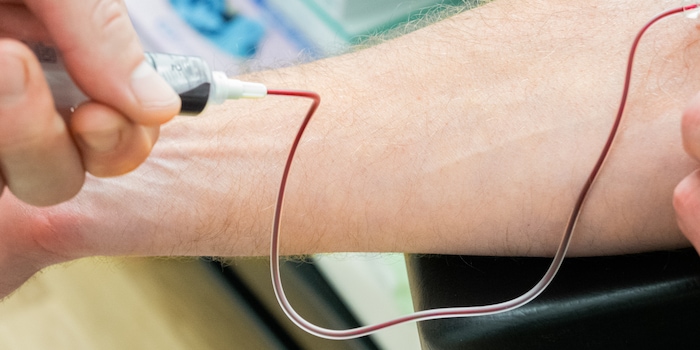
Osteoarthritis is widespread in Switzerland. Over 200 different musculoskeletal issues fall into the category of rheumatic diseases, osteoarthritis being one of them. Orthopaedist Dr Marcel Gloyer uses autohaemotherapy, among other strategies, to treat it.
Until recently, I only really knew the term autologous blood therapy in connection with doping, especially in cycling. Blood doping is a method of increasing the haemoglobin concentration in an athlete’s system by transfusing blood. A certain amount of blood is taken a few weeks before a competition, usually after an altitude training camp. This sample contains more red blood cells and is therefore more efficient, as more oxygen can be transported. The blood is then reinjected shortly before the competition. This method of performance enhancement has been banned since 1985.
However, therapy using your own blood doesn’t just have a performance-enhancing effect, it can also provide relief for musculoskeletal disorders.
The term autologous blood therapy or autologous blood treatment refers to various procedures with one thing in common: a certain amount of blood is first taken from the patient, then reinjected. First attempts at this form of therapy date back to the end of the 19th century. Today, autologous blood therapy is used for osteoarthritis, for example.
Around two million people in Switzerland suffer from rheumatic complaints. Rheumatism is a collective term for over 200 different diseases of the musculoskeletal system. According to Rheumaliga Schweiz, the most common forms include arthritis (joint inflammation)
and osteoporosis (increased bone fragility) as well as arthrosis (joint wear and tear) (websites in German).
The causes of joint osteoarthritis are varied: genetics play a role, as do underlying inflammatory diseases and overloading or incorrectly loading a joint. However, one of the main causes is accidental joint damage. Symptoms range from joint pain and stiffness to restricted mobility. Osteoarthritis is generally considered incurable. Symptoms are usually treated with a mix of therapies. Targeted movement of the affected joint, drug or surgical treatment through joint replacement.

And then there’s autologous blood therapy. Put simply, a doctor takes blood from the patient then injects certain parts of it into the diseased joint. At Zurich’s Alphaclinic (website in German), orthopaedic surgeon Dr Marcel Gloyer treats patients this way.
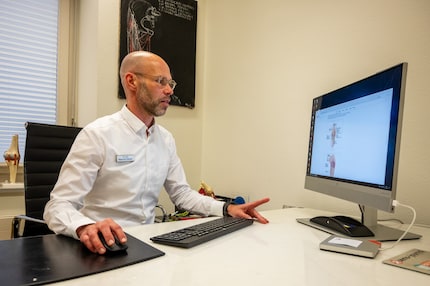
What would a layperson understand by the term autologous blood therapy?
Dr Marcel Gloyer: As the name suggests, it’s a form of therapy using the patient’s own blood. It’s been around for quite a long time, the origins go back over 100 years. Initially, attempts were made to inject the blood back unchanged. However, we now know that this causes inflammatory reactions and increased pain. That’s why today we only inject parts of our own blood.
What do you mean?
Blood consists of various components. We separate these in a centrifuge for around five minutes to obtain three parts: plasma, platelets and red and white blood cells. We then usually use the plasma and platelets in therapy. The aim of therapy with the body’s own blood is to «attract» stem cells using the growth factors contained within. These are cells capable of developing into cartilage cells. In addition, autologous plasma has an anti-inflammatory effect and, unlike cortisone, doesn’t cause any further damage to the tissue.
Platelet-rich plasma, or PRP for short, is often mentioned in connection with autologous blood therapy. What does that mean?
Depending on how the blood is processed in the centrifuge, more or less platelet-rich plasma is produced. The higher the concentration, the more effective the plasma is in the joint. We’re talking about a concentration two to eight times higher after processing. However, a higher concentration is also associated with higher production costs and therefore higher costs.
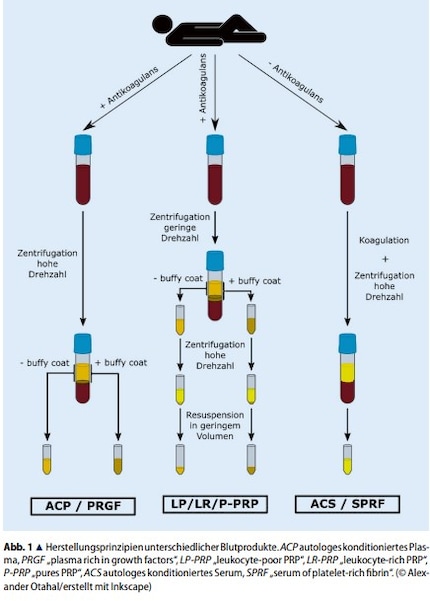
Theory suddenly turns into tangible practice when Marcel Gloyer gets up from his desk and says: «Come on, I’ll show you how it’s done.» No sooner said than done. His blood is taken, then processed in a centrifuge for five minutes. This results in a little plasma he can inject into his knee joint, for example.

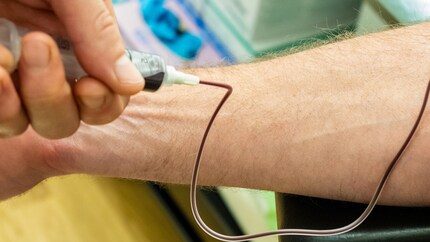
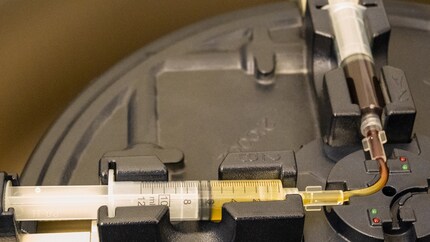
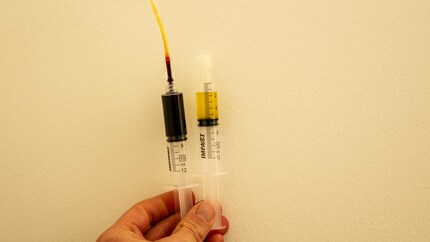
Following that, we return to Marcel Gloyer’s consulting room and talk about money.
Health insurance companies don’t contribute to the costs of autohaemotherapy. Why not?
A medical practice has to first invest in infrastructure: you need the centrifuge and have to buy syringes. Manufacturers demand a high price for both. Each company has its own system, and they aren’t compatible with each other – just like coffee capsules or mobile phone accessories. This results in prices several times higher than those of cortisone, often used today to treat osteoarthritis. One ampoule of cortisone costs around 20 francs. It’s covered by insurance too, as are all services associated with joint injection. The assistant performing the treatment, the material (gloves, cover and disinfectant, syringe, needle, and so on and so forth) and ultimately the doctor’s work for the corresponding injection, all covered.
And how much does an injection of autologous blood cost?
Around 250 francs – depending on the preparation. This includes all services covered by insurance for cortisone injections plus the material for autologous blood. By law, this is a purely private endeavour and an insurance company can’t be billed for autohaemotherapy. The patient must currently bear all costs themselves.
I had cartilage damage in my left knee in 2019. During the subsequent operation, mild to moderate osteoarthritis was also diagnosed. Would autologous blood therapy be a way for me to alleviate the symptoms?
Absolutely. As a rule, we administer three injections with your own blood. This would cost 750 francs. However, treatment is only given when symptoms occur; preventive therapy isn’t recommended.
We’re talking about the knee now. What about other joints?
It’s basically the same. With our centrifuge, we can process blood so that we only get a few millilitres. However, injecting this into a small joint, such as the toe, is practically impossible. Put simply, the bigger the joint, the better.
And what’s the prognosis for alleviating symptoms, given there’s no cure?
The likelihood of autologous blood therapy working is between 80 and 95 per cent. Researchers are working on finding out who needs what type of blood treatment. As a rule, treatment with three injections alleviates symptoms for three to twelve months. As a general rule, the less advanced the osteoarthritis, the greater the chances of autologous blood therapy succeeding.
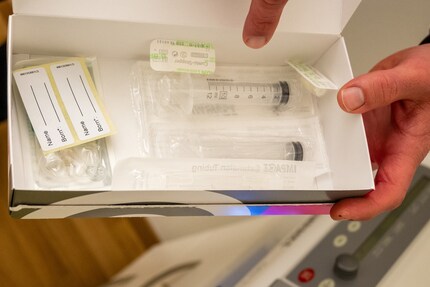
Autologous blood therapy isn’t only used in medicine, no?
It’s marketed in the beauty industry as a miracle cure. The old classic, anti-ageing. The scientific basis here is tenuous. And that’s putting it nicely. I’m guessing that providers here also charge more than 250 francs per syringe, although the preparation of the blood is exactly the same as in the medical field. I definitely wouldn’t have my bald head treated with autologous blood.
Finally, let’s briefly touch on the tiresome subject of doping. You’re also the team doctor for the Swiss Q36.5 Pro Cycling Team. Is blood doping really no longer an issue?
It really isn’t. The so-called No Needle Policy applies in cycling. If I inject anything into a cyclist’s vein (even in an emergency), I must report this to Antidoping Switzerland. If I don’t, the rider must expect consequences. Ultimately, the athlete is always responsible for what goes into their body.
Blood doping is relatively easy to detect in laboratories today, no?
That’s exactly right.
Nevertheless, since the Festina scandal at the 1998 Tour de France, there has always been a general suspicion in cycling.
Riders are under enormous pressure. Cycling is their livelihood, especially materially. If the performance isn’t right and you’re that type of person, the temptation to resort to illicit means is simply too great. This isn’t an excuse, but perhaps an explanation. To emphasise: you probably won’t find a sport that’s monitored as often and as closely as cycling. In addition, you have to be extremely careful what you eat at all times.
**Could you give an example?****
For example, all dietary supplements and all medication taken by a cyclist are checked. Corresponding lists from the UCI, the World Cycling Union and Wada, the World Anti-Doping Agency are published annually. Before I prescribe even one vitamin C powder to an athlete, I have to make sure it’s permitted and clean. In a worst-case scenario, just one contamination that could’ve occurred during production can mean a positive doping test and end a career.
So everything is clean in cycling?
That’d probably be a little naive. Cheaters will find ways to do so. Unfortunately. One thing’s for sure: systematic doping as in years past no longer exists today. We team doctors do our job out of a passion for the sport. Each and every one of us works independently in a practice or clinic and also has a livelihood to lose.
According to Marcel Gloyer, it’ll be years before health insurance companies cover osteoarthritis treatment using autologous blood. Further research and corresponding studies are needed. Until this happens, those affected have no choice but to pay the costs of therapy using their own blood out of their own pocket.
The orthopaedist’s recommendation is that if autologous blood therapy is effective for less than three months, the patient should consider another option. Especially given the costs. If the pain is severe, a cortisone injection into the joint can also provide relief. Surgery is usually the last option for Marcel Gloyer. Here, he relies on minimally invasive techniques and, whenever appropriate, joint preservation.
If this isn’t possible, customised implants (such as a custom-made knee) are used where possible.
This article was published as part of our Focus Week dedicated to the colour red. Seven days, seven stories. Read more about our red-themed week and all the articles published so far here:
Header image: Patrick Bardelli
From radio journalist to product tester and storyteller, jogger to gravel bike novice and fitness enthusiast with barbells and dumbbells. I'm excited to see where the journey'll take me next.
Interesting facts about products, behind-the-scenes looks at manufacturers and deep-dives on interesting people.
Show all
Background information
by Siri Schubert
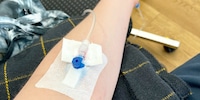
Background information
by Anika Schulz

Background information
by Olivia Leimpeters-Leth